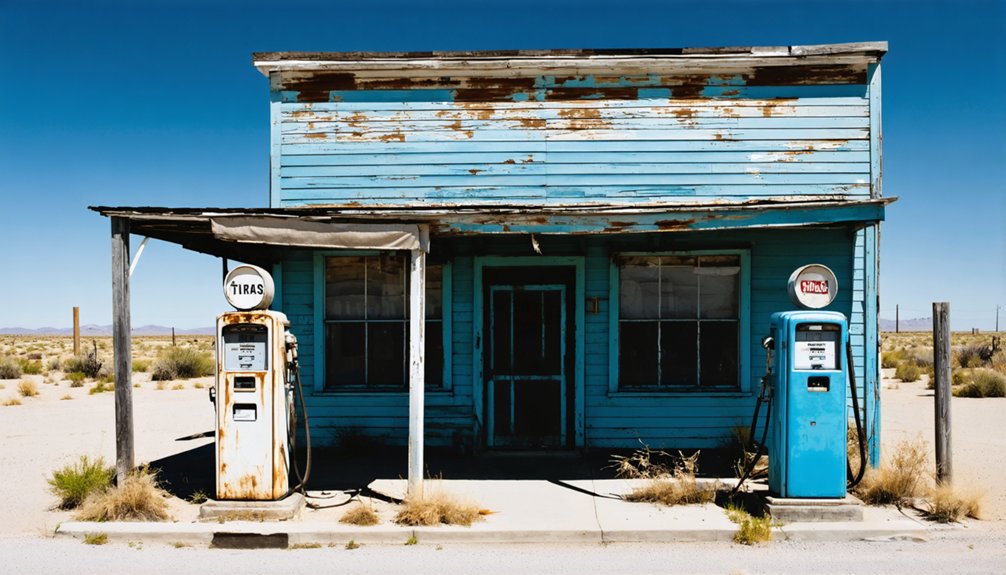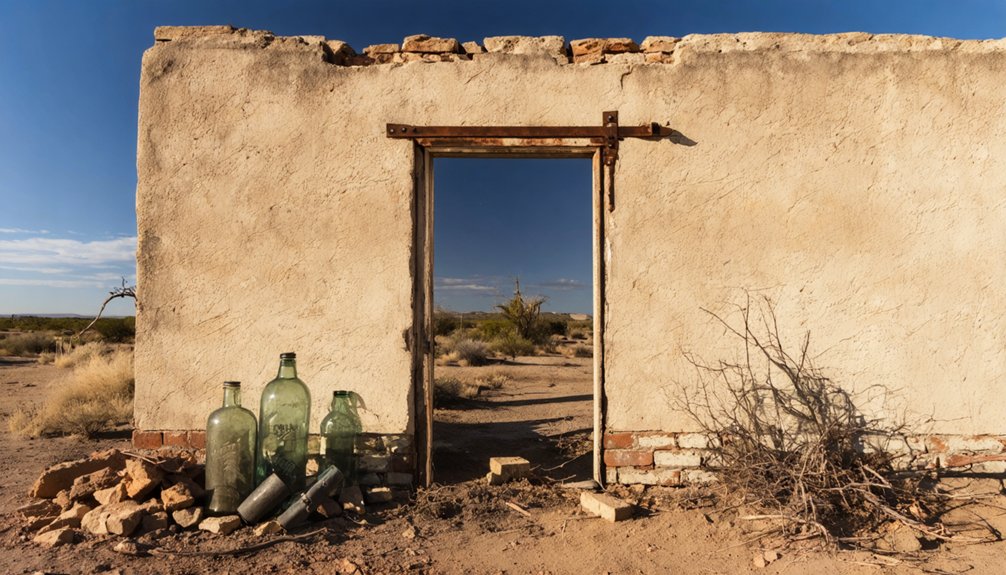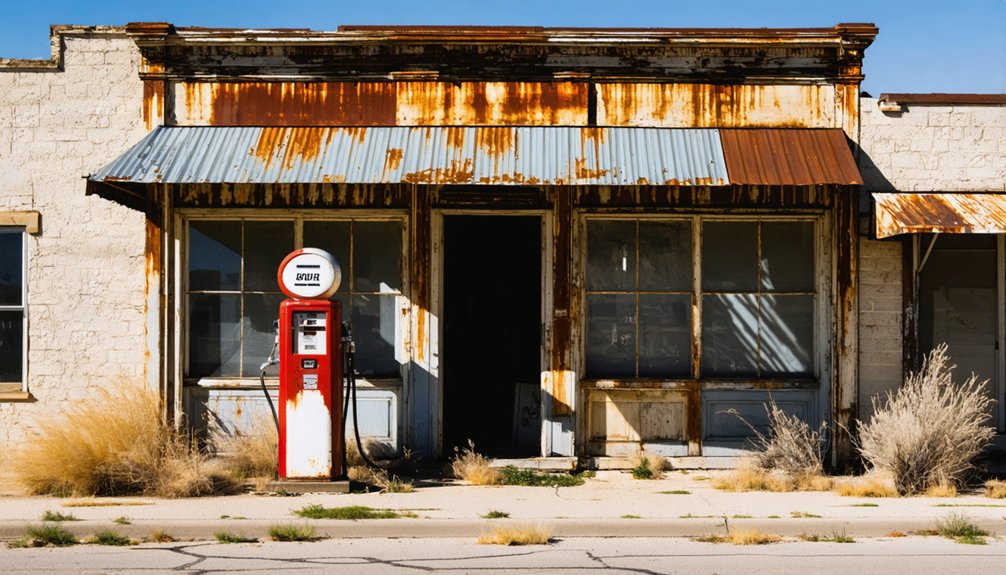You’ll find Dryden, Texas nestled along the former Galveston, Harrisburg and San Antonio Railway line, where it was established in 1882. Named after railroad engineer Eugene E. Dryden, this once-bustling town peaked in the 1920s with over 100 residents before declining during the Great Depression. Today, fewer than 20 people call it home, though its historic post office, ancient pictographs, and infamous 1912 train robbery have left an indelible mark on Texas history.
Key Takeaways
- Dryden, Texas was founded in 1882 as a railroad town and grew to over 100 residents before declining into a ghost town status.
- The town’s economy centered around ranching and railroad operations until the Great Depression led to its eventual decline.
- A historic 1912 train robbery attempt and U.S. Army presence during 1913-1917 mark significant events in Dryden’s history.
- The area features ancient Native American pictographs, including the Meyers Spring Rock Art Site, recognized on the National Register.
- Today, Dryden maintains fewer than 20 residents, with only the post office remaining as a symbol of its former prosperity.
The Birth of a Railroad Town (1882)
When the Galveston, Harrisburg and San Antonio Railway extended its tracks through Terrell County in 1882, it laid the foundation for Dryden’s existence as a railroad town. Named after Eugene E. Dryden, the railway’s chief engineer, this strategic location along the expanding rail line would serve as a crucial maintenance and water stop.
You’ll find the town’s early infrastructure centered around railroad operations, with a section house and wooden depot establishing the core of the settlement. A community center and schoolhouse built in 1912 helped establish essential services for the growing population. The wooden clapboard depot constructed in 1882 became a distinctive landmark for travelers and residents alike.
As railroad expansion brought new opportunities, ranching interests like the Pecos Land and Cattle Company moved in, spurring economic growth. The establishment of a post office in 1888 marked Dryden’s evolution into a proper community, while necessary services and businesses emerged to support both railway personnel and local residents.
Early Pioneers and Town Development
After the railroad’s arrival, pioneer settlers gradually transformed Dryden from a simple rail stop into a proper frontier community.
W.W. Simonds established the first significant pioneer settlement in 1886, building a frame structure that housed essential services. Like the early days of Terry, Texas, the town’s growth was closely tied to railroad development.
Beverly Carter Farley’s arrival in 1889 marked another pivotal moment, as he’d later develop important community infrastructure including the Dryden Hotel and store.
- The Pecos Land and Cattle Company drilled a crucial water well and managed early development until 1895.
- By 1912, settlers had constructed a multipurpose building serving as school, church, and community center.
- The U.S. Army’s presence from 1913-1917 protected the growing settlement during the Mexican Revolution.
This ranching community remained small but self-sufficient, sustained by cattle shipping operations and local commerce that served both residents and travelers. The Galveston, Harrisburg Railway established the town in 1882 as a section house location.
The Infamous 1912 Train Robbery
While Dryden’s frontier community was taking shape, a dramatic event would forever mark its place in Western history.
In the early hours of March 13, 1912, one of Texas’s last great train heists unfolded near Baxter’s Curve. Outlaw legends Ben Kilpatrick, known as the “Tall Texan,” and his partner Ole Hobek attempted to rob Southern Pacific Train #9. A former member of the infamous Wild Bunch gang, Kilpatrick had built a reputation through numerous successful train robberies. The pair had previously plotted in Atlanta prison while serving time for other crimes.
You’ll find their plan was initially successful – they’d managed to separate the passenger cars and begin collecting valuables worth $60,000.
But Wells Fargo messenger David Trousdale turned the tables using an ice mallet from an oyster shipment. In a swift display of courage, he killed both robbers, ending not just the heist but an era of train robberies in Texas.
Life Along the Railroad Line
Since its establishment as a railroad stop in 1882, Dryden emerged as an important link along the Galveston, Harrisburg and San Antonio Railway line. Named after engineer Eugene E. Dryden, the town quickly developed into a vibrant railroad community where daily life revolved around the rhythms of passing trains and maintenance operations.
The railroad shaped every aspect of existence in Dryden:
- Workers lived in adobe and frame houses near the tracks, with engineers, section house keepers, and maintenance crews forming the backbone of the community.
- Essential infrastructure included a significant water well serving both steam locomotives and residents.
- The multipurpose schoolhouse built in 1912 doubled as a church and community center, while the Dryden Hotel and store served travelers and locals alike. That same year, the town gained notoriety when express messenger David Trousdale thwarted a train robbery attempt near the station. The town became a crucial shipping point as Mexican ranchers regularly transported their cattle to the San Antonio market.
Ranching Legacy and Economic Activities
Beyond its role as a railroad hub, Dryden emerged as an essential center for regional ranching operations in the 1880s.
The Massachusetts investors who established their ranch headquarters here in 1884 marked the beginning of significant ranching development in the area. Major enterprises like Harrison Ranch, Block Y Ranch, and Adams Ranch established deep roots here, shaping the area’s economic landscape. These operations showcased diverse ranching practices, from cattle shipping to multi-species livestock management.
If you’d explored Harrison Ranch in its heyday, you’d have seen sheep, Angora goats, and cattle grazing across its expanding 33,000 acres. The ranch’s presence along seven miles of riverfront adds to its historical significance as a prime ranching location.
Today, you can still witness the evolution of livestock diversity as the ranch raises Spanish and Boer cross goats. The Adams Ranch continues its cow-calf operation across 22,000 acres, while many properties combine traditional ranching with modern ventures like hunting and quarrying – reflection of the industry’s adaptability.
Historic Buildings and Landmarks
When you explore Dryden’s oldest landmarks, you’ll find the railway section house from 1882, which served as the town’s first permanent structure during the Galveston, Harrisburg and San Antonio Railway’s expansion.
You can trace the town’s growth through the 1908 establishment of the Dryden Hotel by Beverly Carter Farley, a key figure who shaped the community’s development.
While most structures now lie in ruins, these early buildings represent Dryden’s evolution from a simple railway stop to a frontier town serving travelers and ranch workers alike.
Railroad Section House History
As the Galveston, Harrisburg and San Antonio Railway expanded westward in 1882, Dryden’s railroad section house emerged as an important hub for track maintenance and crew operations.
This utilitarian complex served as both a community hub and critical maintenance station, featuring worker housing, tool storage, and supervisor offices near strategically placed water wells.
You’ll find the section house played three significant roles in Dryden’s history:
- Support center during the last Texas train robbery in 1912
- Protective outpost during the Mexican Revolution (1913-1917)
- Economic lifeline for local ranchers shipping cattle and lambs through the 1920s
The section house’s significance extended beyond railroad maintenance, directly influencing Dryden’s prosperity.
When railroad operations declined during the Great Depression, the town’s population dwindled, eventually leading to its ghost town status.
Dryden Hotel’s Architectural Legacy
The Dryden Hotel emerged in 1912 as a symbol of the town’s railroad-driven prosperity, standing proudly near the bustling section house. Built by rancher Beverly Carter Farley, the multi-story structure showcased early 20th-century rural Texas hotel design with its mixed-use layout combining lodging, retail spaces, and apartments.
You’ll find the hotel’s legacy deeply woven into Dryden’s social fabric. As a crucial community hub, it housed a barber shop, restaurant, and bar while serving as the town’s premier gathering spot.
Despite enduring fire and water damage over the years, preservation efforts maintained its historic character. The building’s blend of local materials and functional architecture continues to represent an era when railroad towns relied on such establishments as essential waypoints for travelers and focal points of commerce.
From Boom to Decline

Founded in 1882 as a railroad section house, Dryden rapidly evolved into a thriving community that peaked with over 100 residents by the 1920s.
You’d have found a bustling town with a hotel, saloon, and community center where locals gathered to build their frontier dreams. The town’s strategic importance even attracted U.S. Army troops during the Mexican Revolution.
The economic shifts that led to Dryden’s decline include:
- The Great Depression’s devastating impact on railroad significance, leading to depot closure
- Changing transportation patterns that bypassed the once-vital rail stop
- The steady exodus of residents as jobs disappeared and services dwindled
Today, you’ll find fewer than 20 residents in what’s now considered a ghost town, though the post office continues to operate as a symbol of Dryden’s resilient spirit.
Native American Heritage and Geography
You’ll discover ancient pictographs in the caves and cliffs surrounding Dryden, evidence of indigenous peoples who inhabited this Chihuahuan Desert region for thousands of years.
The rock art sites, some dating back 3,000 years, showcase the rich Native American heritage through vivid depictions of their desert life and cultural practices.
These remarkable archaeological treasures, paired with Dryden’s rugged desert landscape of steep cliffs and hidden caves, offer glimpses into how native groups adapted to life in this challenging environment.
Ancient Pictograph Rock Art
Nestled near an essential desert spring, Meyers Spring Rock Art Site showcases an extraordinary 100-foot panel of prehistoric and historic pictographs that span thousands of years of human history.
You’ll discover vibrant Pecos River style artwork dating back 3,500 years, painted by ancient Lower Pecos people who recognized this site’s cultural significance.
- Red and black pictographs tell spiritual narratives, depicting cosmological themes like the birth of the sun and changing seasons.
- Indigenous artists later added post-contact imagery showing mounted horsemen, documenting Spanish colonial influence.
- Black Seminole Scouts left their marks in the late 1800s while serving at Fort Meyers, adding another layer to this prehistoric art gallery.
This remarkable site earned its place on the National Register of Historic Places in 1972, preserving countless generations of Native American heritage.
Desert Landscape Features
Dramatic limestone plateaus and wind-swept canyons define the rugged Chihuahuan Desert landscape surrounding Dryden.
You’ll find elevations ranging from 300 to 800 feet, where intermittent streams have carved distinctive erosional patterns through the terrain. Desert springs, like Meyers Spring 12 miles north, served as essential water sources for Native Americans who skillfully navigated this arid environment.
The landscape reveals nature’s raw power through shifting dunes that can tower tens of feet high, particularly visible in nearby Crane and Ward counties.
This dynamic terrain influenced how indigenous peoples traveled and hunted across the region. The area’s unique position near the Edwards Plateau and Rolling Plains created diverse ecological zones where Native Americans gathered critical desert plants like mesquite for food, medicine, and materials.
Preserving Dryden’s Story Today

While many ghost towns fade into obscurity, dedicated efforts to preserve Dryden’s rich history continue through various channels today.
Community involvement and historic preservation remain essential, as local stakeholders work to maintain both physical structures and cultural heritage.
Local champions unite to protect and sustain Dryden’s physical landmarks and cultural legacy for future generations.
You’ll find three primary preservation efforts in action:
- Documentation through historical websites, local societies, and tourism boards that maintain detailed records of Dryden’s railroad and military past.
- Physical conservation of key structures like the post office, Baptist church, and historic water tank erected by John Bullis.
- Educational initiatives centered around Meyers Spring’s pictographs, which earned National Register of Historic Places status in 1972.
Through these combined efforts, you’re witnessing how a determined community keeps their heritage alive despite the challenges of desert weathering and dwindling population.
Frequently Asked Questions
What Is the Nearest Major City to Dryden, and How Far Away?
You’ll find Del Rio’s your nearest major city, about 100 miles southeast along U.S. Route 90. The travel distance typically takes you between 1.5 to 2 hours through West Texas terrain.
Are There Any Descendants of Original Dryden Settlers Still Living There?
You’ll find no verified descendant stories linking today’s handful of residents to original settlers. While family histories may exist regionally, there’s no documented evidence of direct lineage in Dryden itself.
Can Visitors Access the Historic Train Robbery Site Today?
You can reach the historic train robbery site, but there’s no formal public access or facilities. You’ll need to navigate private ranch lands and remote terrain independently with proper permissions.
What Happened to the Dryden Hotel Building After the Town Declined?
You’ll find the hotel building’s still standing, thanks to ongoing restoration efforts. It now operates as a bar & grill with upstairs studios, preserving its role as a community gathering place despite population decline.
Were Any Movies or Documentaries Ever Made About Dryden’s History?
Like tumbleweeds rolling past forgotten storefronts, Dryden’s story remains largely undocumented on film. You won’t find any movie adaptations or historical documentaries specifically about this remote Texas ghost town’s past.
References
- https://www.legendsofamerica.com/tx-dryden/
- https://allacrosstexas.com/texas-ghost-town.php?city=Dryden
- https://www.texasescapes.com/WestTexasTowns/DrydenTexas.htm
- https://en.wikipedia.org/wiki/Dryden
- https://kids.kiddle.co/Dryden
- https://www.thestoryoftexas.com/discover/artifacts/SPR-stained-glass-window
- https://www.tshaonline.org/handbook/entries/dryden-tx
- https://www.tshaonline.org/handbook/entries/terrell-county
- https://www.ozona.com/the-ghost-town-of-dryden-tx
- http://www.wtblock.com/Terry.htm



